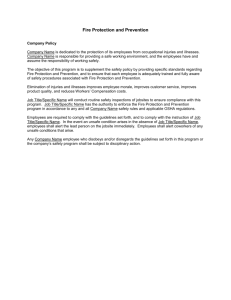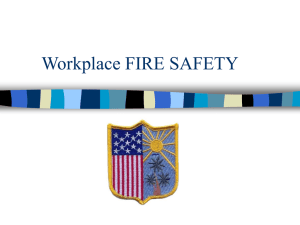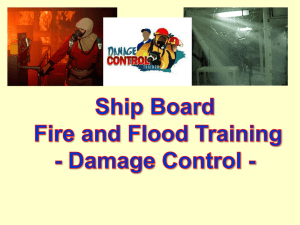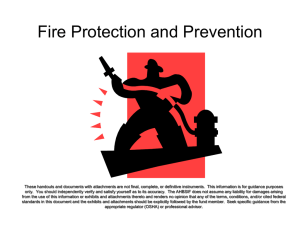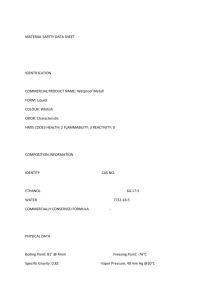Flammable and Combustible Liquids
advertisement
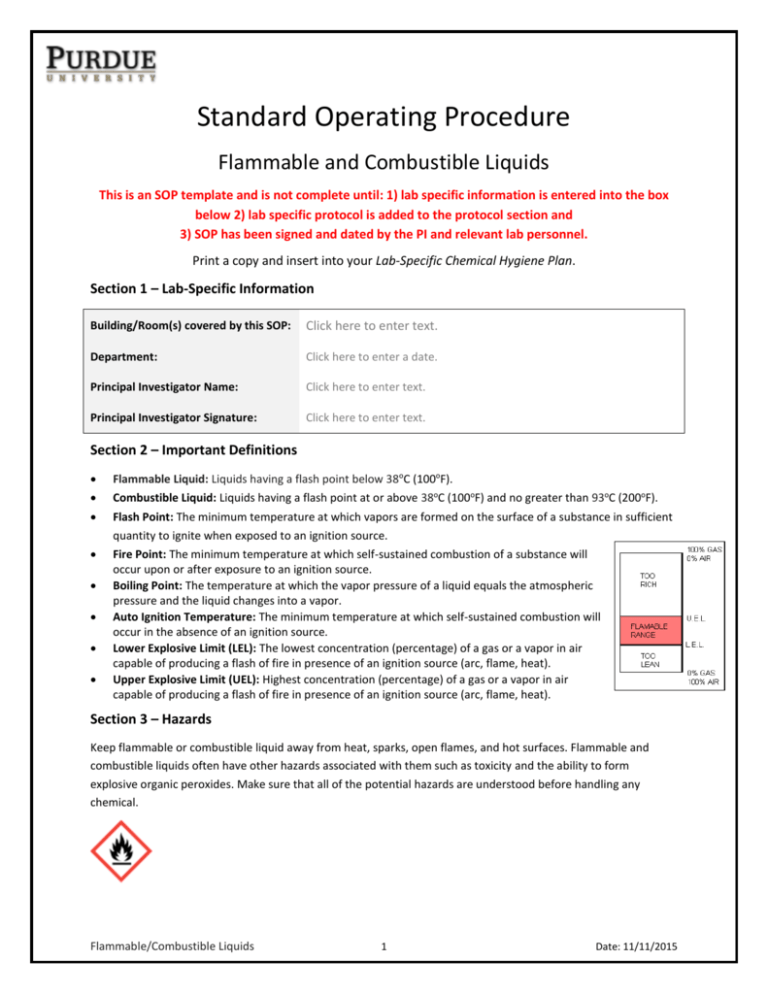
Standard Operating Procedure Flammable and Combustible Liquids This is an SOP template and is not complete until: 1) lab specific information is entered into the box below 2) lab specific protocol is added to the protocol section and 3) SOP has been signed and dated by the PI and relevant lab personnel. Print a copy and insert into your Lab-Specific Chemical Hygiene Plan. Section 1 – Lab-Specific Information Building/Room(s) covered by this SOP: Click here to enter text. Department: Click here to enter a date. Principal Investigator Name: Click here to enter text. Principal Investigator Signature: Click here to enter text. Section 2 – Important Definitions Flammable Liquid: Liquids having a flash point below 38oC (100oF). Combustible Liquid: Liquids having a flash point at or above 38oC (100oF) and no greater than 93oC (200oF). Flash Point: The minimum temperature at which vapors are formed on the surface of a substance in sufficient quantity to ignite when exposed to an ignition source. Fire Point: The minimum temperature at which self-sustained combustion of a substance will occur upon or after exposure to an ignition source. Boiling Point: The temperature at which the vapor pressure of a liquid equals the atmospheric pressure and the liquid changes into a vapor. Auto Ignition Temperature: The minimum temperature at which self-sustained combustion will occur in the absence of an ignition source. Lower Explosive Limit (LEL): The lowest concentration (percentage) of a gas or a vapor in air capable of producing a flash of fire in presence of an ignition source (arc, flame, heat). Upper Explosive Limit (UEL): Highest concentration (percentage) of a gas or a vapor in air capable of producing a flash of fire in presence of an ignition source (arc, flame, heat). Section 3 – Hazards Keep flammable or combustible liquid away from heat, sparks, open flames, and hot surfaces. Flammable and combustible liquids often have other hazards associated with them such as toxicity and the ability to form explosive organic peroxides. Make sure that all of the potential hazards are understood before handling any chemical. Flammable/Combustible Liquids 1 Date: 11/11/2015 Section 4 – Engineering Controls and Personal Protective Equipment (PPE) Engineering Controls: Use of flammable and combustible liquids should be conducted in a properly functioning chemical fume hood whenever possible. The chemical fume hood must be approved and certified by REM and have a face velocity between 80 – 125 feet per minute. Hygiene Measures: Avoid contact with skin, eyes, and clothing. Wash hands before breaks and immediately after handling the product. Hand Protection: Chemical-resistant gloves must be worn, nitrile gloves are recommended for low volume applications. Wearing two pairs of nitrile gloves is recommended. If handling a high volume (> 1 liters) of flammable or combustible liquid, then disposable gloves are likely not suitable; a more heavy duty glove such as a butyl rubber is required. NOTE: Consult with your preferred glove manufacturer to ensure that the gloves you plan on using are compatible with the specific chemical being used. Eye Protection: ANSI approved properly fitting safety glasses or chemical splash goggles are required. A face shield may also be appropriate depending on the specific application. Skin and Body Protection: Laboratory coats must be worn and be appropriately sized for the individual and buttoned to their full length. Flame resistant lab coats must be worn when handling volumes greater than 1 liter. Personnel must also wear full length pants, or equivalent, and close-toed shoes. Full length pants and close-toed shoes must be worn at all times by all individuals that are occupying the laboratory area. The area of skin between the shoe and ankle must not be exposed. Respiratory Protection: If flammable and/or combustible liquids are being used outside of a chemical fume hood, respiratory protection may be required. If this activity is necessary, contact REM (49-46371) so a respiratory protection analysis can be performed. Section 5 – Special Handling and Storage Requirements A designated storage area must be established for flammable and combustible liquids such as a flammable storage cabinet (as shown to the right). No more than 37 liters (10 gallons) of flammable liquid is permitted to be stored outside of a flammable storage cabinet/area. A current copy of the SDS for the specific flammable/combustible liquids being used must be made available to all personnel working in the laboratory at all times. Do not over purchase; only purchase what can be safely stored in the laboratory. Avoid contact with skin, eyes, and inhalation. Keep away from sources of ignition. Keep containers tightly closed. Store in a cool, dry, and well-ventilated area away from incompatible substances such as oxidizers. Follow laboratory supervisor’s instructions for PPE, which may differ depending on the type and/or quantity of flammable/combustible liquid being used. Use in the smallest practical quantities for the experiment being performed. Work must be conducted in a chemical fume hood if air concentrations above 10% of the LEL could be created, if the chemical is irritating to the eyes or respiratory system, and/or is toxic by inhalation. Containers should remain closed when not in use. This is to preventing accumulation of flammable vapor concentrations and accidental ignition. Flammable/Combustible Liquids 2 Date: 11/11/2015 Containers should be labeled appropriately. Label should indicate the name of the chemical(s) in the container. Avoid using chemical abbreviations (acceptable if a legend is present in the lab) and formulae. When not in use, store in flammable storage cabinets if possible. Containers should be in good condition and compatible with the material; store in safety cans (spring closing lid, as illustrated to the right) if possible. Avoid using ignition sources (flame burners or any open flame source, hot plates, electrical equipment with frayed or cracked wiring, etc.) and/or creating static electricity in areas where flammable/combustible chemicals are being used. Ground and bond containers when transferring more than 4 liters of flammable/combustible liquids. Transport all flammable/combustible liquids in secondary containment, such as polyethylene or other non-reactive acid/solvent bottle carrier. Flammable/combustible liquids must be segregated from incompatible materials such as oxidizers (e.g., hydrogen peroxide, nitric acid). Incompatibilities will be noted in Section 10 of the SDS, “Stability and Reactivity”. If flammable liquids will be stored in refrigerators or freezers, these will be specially modified or purposemade “flammable-safe” refrigerators and freezers which have no internal sources of ignition posed by an internal light or thermostat circuit. Section 6 – Spill and Accident Procedures Immediately evacuate area and ensure others are aware of the spill. If there is an imminent threat of a fire, pull the nearest fire alarm station to evacuate the building and dial 911. If personnel have become exposed and need medical assistance, dial 911. If the spill is minor and does not pose a threat to personnel, contact REM at 49-40121 during normal business hours (Monday – Friday, 7 AM – 4 PM) for spill cleanup assistance (dial 911 if spill occurs after hours and assistance is needed). Section 7 – Waste Disposal Procedures Store hazardous waste in closed containers that are properly labeled, and in a designated area (flammable cabinet is recommended). Flammable and combustible liquid waste should be segregated from all incompatibles such as oxidizers. No flammable or combustible liquids (including alcohols) are permitted to be poured down the drain. Complete a Chemical Waste Pickup Request Form to arrange for disposal by REM; detailed instructions are provided at the following link: http://www.purdue.edu/ehps/rem/hmm/chemwaste.htm. Section 8 – Protocol (Additional lab protocol may be added here) Click here to enter text. NOTE: Any deviation from this SOP requires approval from the Principal Investigator. Section 9 – Documentation of Training (signature of all users is required) Prior to conducting any work with flammable/combustible liquids, the Principal Investigator must ensure that all laboratory personnel receive training on the content of this SOP. I have read and understand the content of this SOP: Flammable/Combustible Liquids 3 Date: 11/11/2015 Name Signature Date Click here to enter text. Click here to enter a date. Click here to enter text. Click here to enter a date. Click here to enter text. Click here to enter a date. Click here to enter text. Click here to enter a date. Click here to enter text. Click here to enter a date. Click here to enter text. Click here to enter a date. Click here to enter text. Click here to enter a date. Click here to enter text. Click here to enter a date. Click here to enter text. Click here to enter a date. Click here to enter text. Click here to enter a date. Click here to enter text. Click here to enter a date. Click here to enter text. Click here to enter a date. Flammable/Combustible Liquids 4 Date: 11/11/2015

